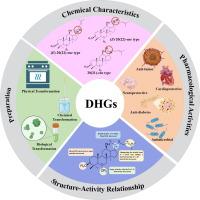脱水人参皂苷的兴起:植物化学和药理学
IF 13
1区 综合性期刊
Q1 MULTIDISCIPLINARY SCIENCES
引用次数: 0
摘要
人参属植物,如人参、三七和西洋参,几千年来一直被用于烹饪和药用。它们的药理作用很大程度上归因于人参皂苷-一种独特的化合物,从达马拉烷二醇和达马拉烷三醇的糖基化中提取。稀有人参皂苷是天然存在的低丰度(通常为 <; 0.1 %)的达马烷型三萜,通常比巨量人参皂苷表现出更强的生物活性。脱水人参皂苷(dhg,如Rk1, Rg5, Rk2)在达玛烷侧链上以C‑20/21或C‑20/22双键为特征,构成了稀有人参皂苷的一个亚群,在本地人参物种中稀缺或不存在,但在加工产品中富集。构效关系研究表明,与前体人参皂苷相比,用双键取代C - 20羟基可以提高生物活性。尽管有这样的希望,但对dhg的综合和全面审查一直缺乏。本文系统地综述了dhg的化学结构特征、制备策略、药理作用及其机制、构效关系等方面的研究进展,为dhg的治疗潜力和应用前景提供新的认识。迄今为止,共鉴定出92种具有不同骨架的dhg,包括Δ20-PPD型dhg(如人参皂苷Rk1、Rg5、Rk2和Rh3), Δ20-PPT型dhg(如人参皂苷Rk3、Rh4、Rg6和F4)及其侧链衍生物。目前dhg的制备方法包括物理、化学和生物转化、化学合成和批量处理技术。dhg具有广泛的药理活性,如抗肿瘤、抗糖尿病、神经保护、心血管保护和抗菌作用,通常超过其前体人参皂苷。本文还探讨了dhg的构效关系,以指导更有效衍生物的开发。本文章由计算机程序翻译,如有差异,请以英文原文为准。

The rise of dehydrated ginsenosides: phytochemistry and pharmacology
Background
Plants of the Panax genus, such as P. ginseng, P. notoginseng, and P. quinquefolius, have been utilized for culinary and medicinal purposes for millennia. Their pharmacological effects are largely attributed to ginsenosides—unique compounds derived from the glycosylation of dammaranediol and dammaranetriol. Rare ginsenosides are dammarane-type triterpenoids that occur naturally at low abundance (typically < 0.1 %) and often exhibit stronger bioactivity than macro ginsenosides. Dehydrated ginsenosides (DHGs, e.g., Rk1, Rg5, Rk2), characterized by a C‑20/21 or C‑20/22 double bond on the dammarane side chain, constitute a subgroup of rare ginsenosides that are scarce or absent in native Panax species but enriched in processed products. Structure–activity relationship studies indicate that replacing the C‑20 hydroxyl with a double bond enhances bioactive properties relative to precursor ginsenosides. Despite this promise, an integrative and comprehensive review of DHGs has been lacking.Aim of review
This review systematically summarizes the current knowledge on DHGs, covering their chemical structure characteristics, preparation strategies, pharmacological activities with underlying mechanisms, and structure–activity relationships, providing new insights into their therapeutic potential and future applications.Key scientific concepts of review
To date, a total of 92 DHGs with diverse skeletons have been identified, including Δ20-PPD type DHGs (e.g., ginsenosides Rk1, Rg5, Rk2, and Rh3), Δ20-PPT type DHGs (e.g., ginsenosides Rk3, Rh4, Rg6, and F4) and their side chain derivatives. Current preparation methods for DHGs encompass physical, chemical, and biological transformations, chemical synthesis, and batch-processing techniques. DHGs demonstrate a broad spectrum of pharmacological activities—such as anti-tumor, anti-diabetic, neuroprotective, cardiovascular protective, and antimicrobial effects—often surpassing their precursor ginsenosides. This review also explores the structure–activity relationships of DHGs to guide the development of more effective derivatives.求助全文
通过发布文献求助,成功后即可免费获取论文全文。
去求助
来源期刊

Journal of Advanced Research
Multidisciplinary-Multidisciplinary
CiteScore
21.60
自引率
0.90%
发文量
280
审稿时长
12 weeks
期刊介绍:
Journal of Advanced Research (J. Adv. Res.) is an applied/natural sciences, peer-reviewed journal that focuses on interdisciplinary research. The journal aims to contribute to applied research and knowledge worldwide through the publication of original and high-quality research articles in the fields of Medicine, Pharmaceutical Sciences, Dentistry, Physical Therapy, Veterinary Medicine, and Basic and Biological Sciences.
The following abstracting and indexing services cover the Journal of Advanced Research: PubMed/Medline, Essential Science Indicators, Web of Science, Scopus, PubMed Central, PubMed, Science Citation Index Expanded, Directory of Open Access Journals (DOAJ), and INSPEC.
 求助内容:
求助内容: 应助结果提醒方式:
应助结果提醒方式:


